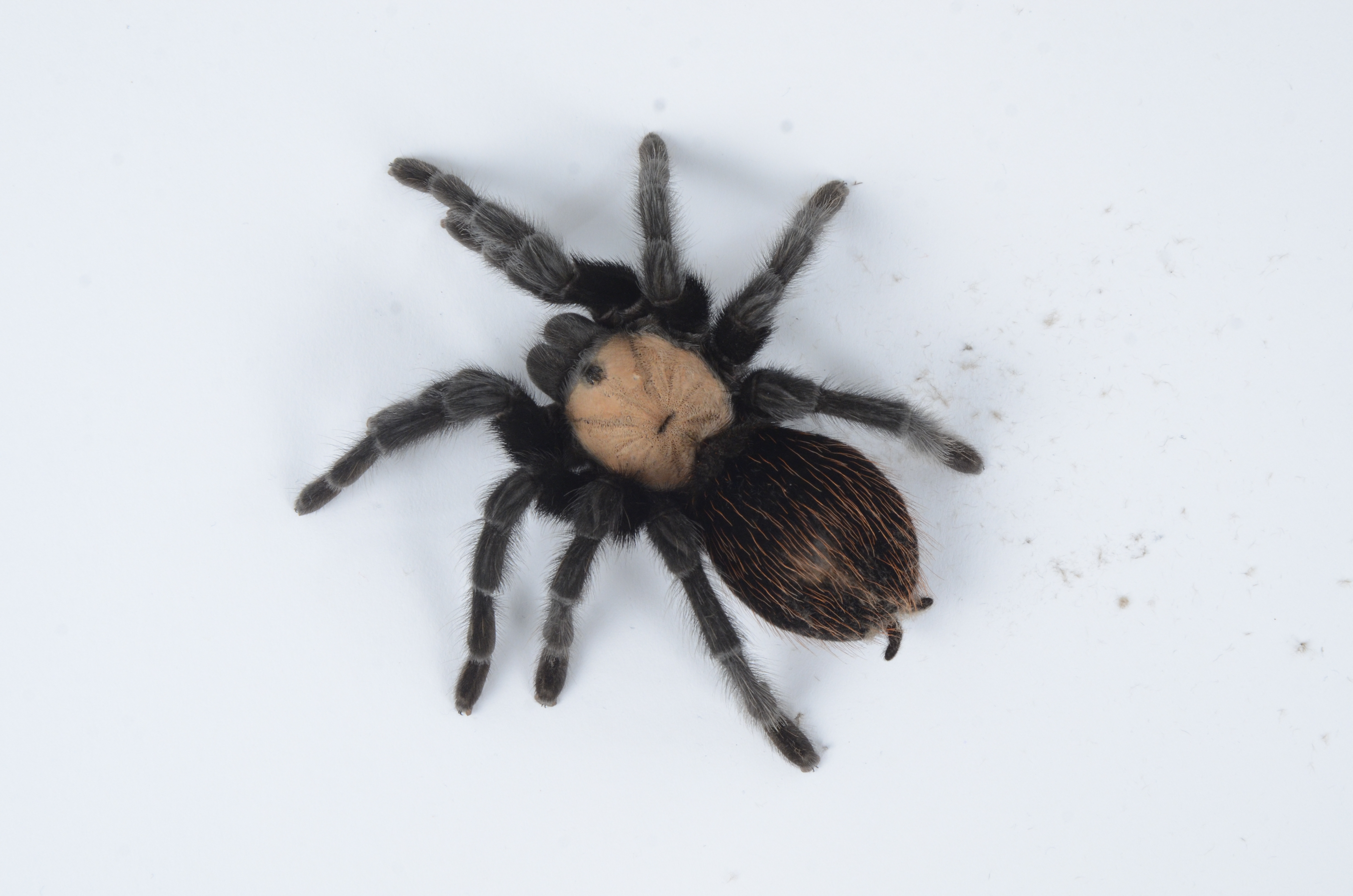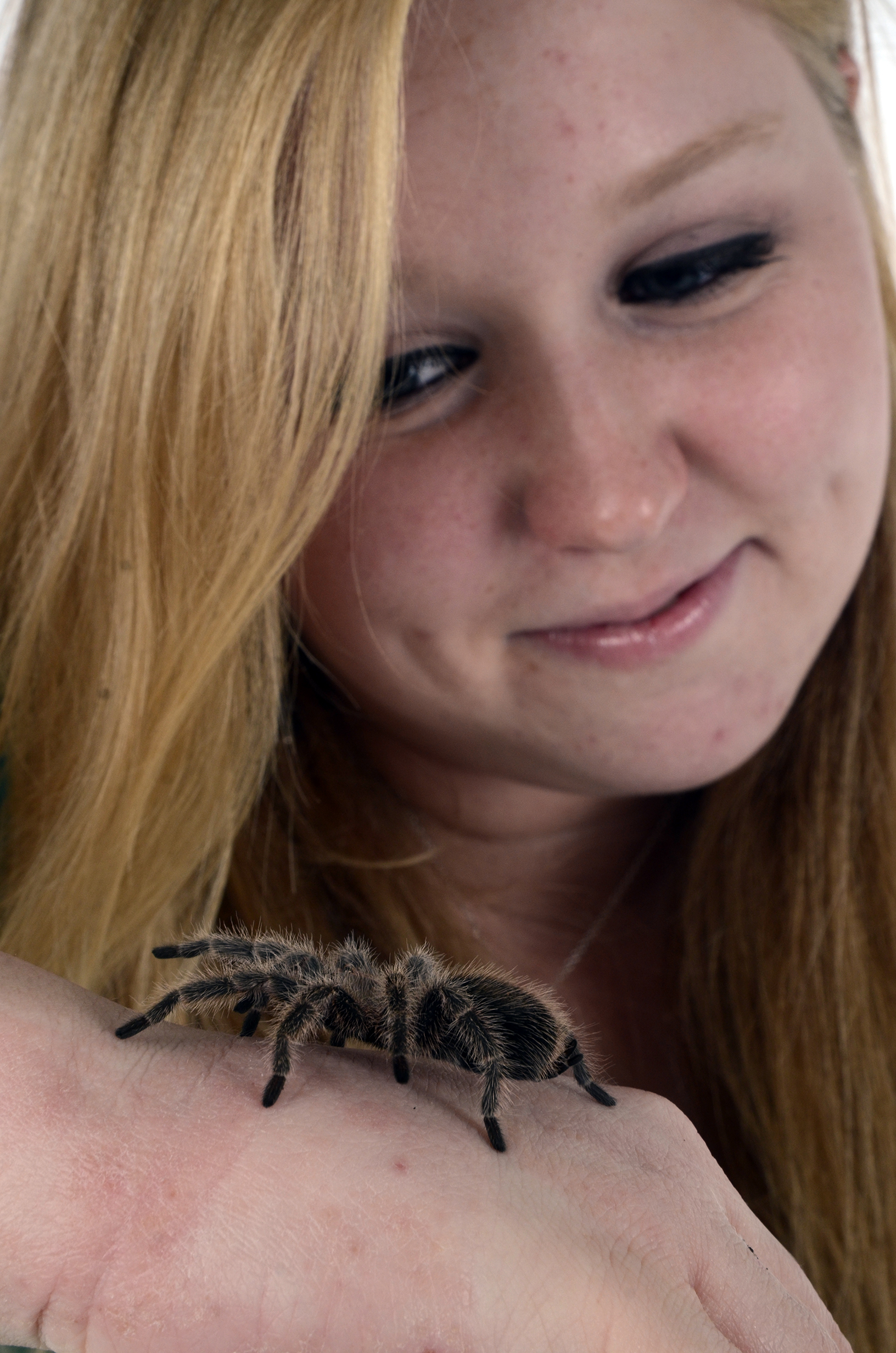Catelyn Topping was only 15 years when she fell in love.
With tarantulas.
It wasn't love at first sight, she says. It took an entire week.
"I started volunteering at Chattanooga Zoo and there was one keeper who had a room full of tarantulas," Topping says. "She was on vacation so I watered and fed them. At first it was terrifying, but by the second week, I was in love. I thought it was amazing how they ate and how pretty some of them are. They were so cool to me and I was fascinated."
Topping, 21, of Flintstone, Ga., and an employee at a local day care and a gaming store, now has 16 tarantulas living in her home. She calls them her "babies."
"I have a good variety - an Amazon Tree Climber, a Brazilian Black, Vientiane Purple, Pinktoe - one of my favorites due to the fact she is purple - Chilean Rose Hair, Chilean Copper, Mexican Red Knee, Mexican Red Leg, Mexican Red Rump and Pink Zebra Beauty," she says.
According to the National Institute of Mental Health, arachnophobia, the fear of spiders, is ranked the third in America with an estimated 30.5 percent of people suffering from it (fear of public speaking ranked No. 1 at 74 percent, followed be a fear of death at 68 percent). And if you have arachnophobia, tarantulas, being the largest of all spiders, will likely send your fears into turbodrive.
"I completely understand people's fears," Topping says. "They can be a bit scary. They're big, sometimes hairy, and can move super fast - not to mention their giant fangs. But I think if people understood they won't hurt you unless you are trying to hurt them. They make it clear when they don't want to be bothered and when they're going to attack. It's normal to be scared of what you don't understand."
All tarantulas can bite, but most owners say it's no worse than a bee sting, unless you
are allergic. If you are, it can be fatal. Although there is no documented case of a fatal tarantula bite, some of the spiders have more potent venom than others, and there is no anti-venom, so you treat the symptoms - benadryl, for instance, just like with a bee sting - and hope for the best.
Scott Carver, a manager at Petco on Gunbarrel Road, says education is the key to rid one's fear of tarantulas, which are sold at his store in prices ranging from $20 to $200. The bigger the tarantula, the higher the price, he says.
"I've been handling tarantulas in the store 10 years and 30 years before that, and I've never been bitten," the 48-year-old says. "They will bite only when they feel threatened or when they're laying eggs."
Topping, whose tarantulas range in age from 4- to 16-years-old and live in cages, has never been bitten. There is one, though, who is aggressive.
"It's a Chilean Rose Hair, which are quite gentle, but she has become an exception. She attacks everything, even when she's not hungry. I never try to hold her, but I still admire her. She is very active and fun to watch."
So with all that hair and huge fangs and eight legs and general scariness, why do people keep and study tarantulas? For expert Stan Schultz, it's about the exotic. The 70-year-old from Calgary, Alberta, told The Associated Press that he got interested in the critters when he was young because normal pets became boring.
For more than 45 years, Schultz has kept, caught, imported, bred, sold, wrote and lectured about tarantulas. His book, "The Tarantula Keeper's Guide," is in its third edition and headed to its fourth.
At one time, he had 1,300 tarantulas - all with names. There are many things about the spiders that are intriguing, he says, but perhaps the most interesting thing is "dare I say it, intelligence."
"But, before you get your hopes up, they're still closer to a cabbage than the family dog in smarts."
Claire Whittington of Regina, Saskatchewan but formerly of Chattanooga, has a palm-sized Chilean Rose Hair named - naturally - Spider.
"She is a lovely pet - quiet, easy to look after and non-aggressive," Whittington says. "She is pretty and very docile."
Topping also sees her tarantulas as pets, holding them frequently and petting them.
"Depending on the breed, some have course hair while others are as soft as velvet," she says, with each having specific features that identify them. "I can look at them and instantly know if it's a certain one. I don't understand how people say they look the same. I guess I notice little quirks, like the way they move."
The more one holds a tarantula, the more comfortable it becomes with humans, Topping says.
"If you don't hold them often, over time they will OVERSET FOLLOWS:become distant and not as friendly. They do recognize me by my smell and I notice I can hold one of my babies and they are calm, but if a family member holds them, they will constantly move and run off their hands. I have a couple who will lean into my finger when I pet them."
If you're interested in owning one, it's not as simple as just going to a pet store and picking one out. Petco, for instance, doesn't allow just anyone to buy a tarantula, Carver says.
"The spiders are not sold to anyone under 18," he says. The typical buyer are males ages 22 to 26, he says.
All Petco staff members who handle the tarantulas are educated about the spider and its proper care. The same holds true for customers.
"We educate customers who buy them about what they're in for - the spiders require a particular humidity, heat source and light," Carver says. "We give (customers)tearsheets about caring for them."
Carver says people with breathing problems such as asthma, and children who are "hands-y," should not be around tarantulas.
"These issues can frighten a spider and, when tarantulas feel threatened they're likely to use their back legs to flick their hairs. These hairs can go in the person's eyes or lungs. If they go in the lungs, it can cause an infection," he says.
The tarantula starts life as a sling - short for spiderling - so they can be as small as a fingernail and grow as large as a dinner plate. It eats mostly live crickets, cockroaches and some mice. Like all spiders, tarantulas turn prey into stew by pumping in venom through its fangs.
Topping finds their eating habits to be especially entertaining since no two tarantulas have the same habits.
"It's really cool to watch," she says. "You never know what to expect. One of my favorites is my Mexican Red Rump who catches as many crickets as she can and will balance on two legs while holding as many as she can under her stomach in a web belt. She wobbles. I find it hilarious and I'm waiting for the day she falls over."
Female tarantulas are known to kill the male tarantula after mating, and it's that possible scenario that keeps Topping from mating her males and females.
"I was trying help a friend breed a pair and the poor little male was doing his little 'tap dance' and the female had no interest whatsoever," she says.
The result, she says, was fatal to the male.
The Associated Press contributed to this story.
Contact staff writer Karen Nazor Hill at khill@timesfreepress.com or 423-757-6396.


